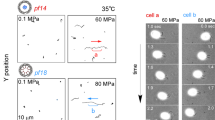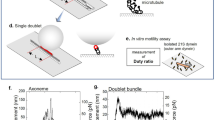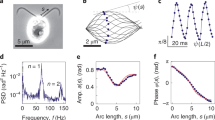Abstract
MECHANISMS controlling cell behaviour are of considerable importance in biology and medicine, and much effort has been expended in experiments designed to evaluate the biochemical events which are involved in the mediation of a variety of cellular activities. Calcium ions are found to be involved in the regulation of a number of motile processes, such as muscular contraction1, ciliary reversal2 and cytoplasmic contraction3. We present here preliminary results which show that calcium may be responsible for the control of flagellar activity in a trypanasomid flagellate, Crithidia oncopelti. The flagellum of this organism propagates waves both distally and proximally in common with other trypanosomes4 but in contrast to the flagella on the majority of other protozoa and spermatozoa which are observed to maintain only distally propagating waves5. During normal swimming Crithidia propagates waves from tip to base, but on meeting an obstruction wave reversal occurs for several flagellar beats, thereby causing the organism to reverse its direction of movement and enabling it to escape from the obstacle. The wave reversal thus seems to be an avoidance reaction, and can be induced by mechanical, electrical or chemical stimulation6.
This is a preview of subscription content, access via your institution
Access options
Subscribe to this journal
Receive 51 print issues and online access
$199.00 per year
only $3.90 per issue
Buy this article
- Purchase on Springer Link
- Instant access to full article PDF
Prices may be subject to local taxes which are calculated during checkout
Similar content being viewed by others
References
Ebashi, S., and Endo, M., Prog. Biophys. molec. Biol., 18, 123–183 (1968).
Naitoh, Y., and Kaneko, H., J. exp. Biol., 58, 657–676 (1973).
Taylor, D. L., Condeelis, J. S., Moore, P. L., and Allen, R. D., J. Cell Biol., 59, 378–394 (1973).
Holwill, M. E. J., J. exp. Biol., 42, 125–137 (1965).
Sleigh, M. A., in Cilia and Flagella (edit. by Sleigh, M. A.), 79–92 (Academic, New York and London, 1974).
Holwill, M. E. J., and McGregor, J. L., J. exp. Biol., 60, 437–444 (1974).
Douglas, G. J., and Holwill, M. E. J., J. Mechanochem. Cell Motility, 1, 213–223 (1972).
Portzehl, H., Caldwell, P. C., and Ruegg, J. C., Biochim. biophys. Acta, 79, 581–591 (1964).
Pressman, B. C., Fedn Proc., 32, 1698–1703 (1973).
Satir, P., in Cilia and Flagella (edit. by Sleigh, M. A.), 131–142 (Academic, New York and London, 1974).
Naitoh, Y., J. gen. Physiol., 53, 517–529 (1969).
Brokaw, C. J., Josslin, R., and Bobraw, L. (in the press).
Author information
Authors and Affiliations
Rights and permissions
About this article
Cite this article
HOLWILL, M., McGREGOR, J. Control of flagellar wave movement in Crithidia oncopelti. Nature 255, 157–158 (1975). https://doi.org/10.1038/255157a0
Received:
Accepted:
Issue Date:
DOI: https://doi.org/10.1038/255157a0
This article is cited by
-
Role of calmodulin and calcineurin in regulating flagellar motility and wave polarity in Leishmania
Parasitology Research (2017)
-
Reactivation of flagellar motility in demembranated Leishmania reveals role of cAMP in flagellar wave reversal to ciliary waveform
Scientific Reports (2016)
-
Calcium couples flagellar reversal to photostimulation in Chlamydomonas reinhardtii
Nature (1976)
-
Electron microscopy and electron probe analysis of the Ca-binding sites in the cilia ofParamecium caudatum
Experientia (1976)
-
Ca-induced arrest response in Triton-extracted lateral cilia ofMytilus gill
Experientia (1976)
Comments
By submitting a comment you agree to abide by our Terms and Community Guidelines. If you find something abusive or that does not comply with our terms or guidelines please flag it as inappropriate.



